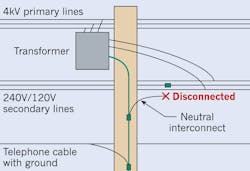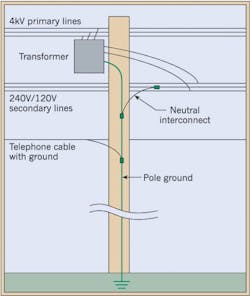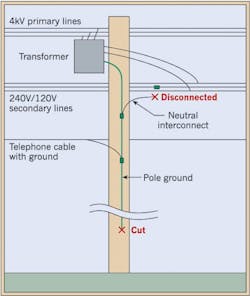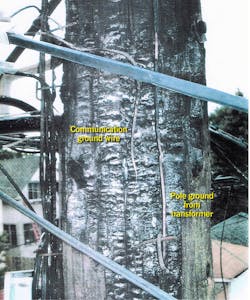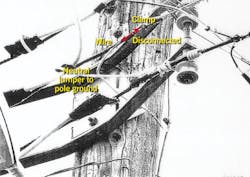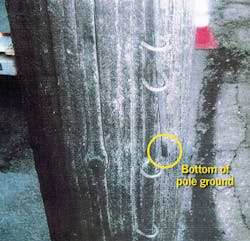The Case of the Utility Pole Predicament
Utility poles typically feature a combination of power conductors and communication cables, such as phone or cable television. Power wiring can vary from a simple support pole to a more complex transformer pole. Workers representing each of these entities regularly climb these poles to perform installation and maintenance on their systems. Therefore, they are exposed to a variety of hazards that come with this type of work, including electric shock and burns, physical injuries, and fall hazards. Contractual relationships often dictate responsibilities for the poles themselves and the various systems hanging on them as well as for the safety of workers who climb them. However, even when a worker does everything right, an accident can happen — as it did in this particular case.
Troubleshooting the problem
A phone company employee was sent out to investigate a phone service problem at a residence. After an initial evaluation at the house, he determined the problem was somewhere in the external system. Next, he prepared to climb the pole to troubleshoot further.
His preparation involved placing safety cones around his van, donning a protective hard hat, safety glasses, work gloves, and safety belt, and preparing a voltage detector for use. That tester (a popular model for this type of task) contains a sharp pointed probe used to make contact with objects even through paint. Visual and audible signals alert when the probe contacts an electrically energized surface. Following his training and the company’s published safety protocol, he used the voltage detector around the base of the pole, but found very few metallic objects that could be energized. A nearby fence gave a safe indication as well, and there was no pole ground conductor visible.
The accident
Next, the technician began climbing the pole, first using the ladder and then the pole steps up to where he needed to be. While climbing, he maintained three points of contact with the pole steps at all times (in accordance with his training), which prohibited the use of his hands for any other task. When he arrived at his destination, he reached around the pole to install his safety belt and free up his hands so that he could use his voltage detector to verify safe conditions at that level. As he reached around the pole, however, he received a severe electric shock, fell to the ground, and sustained significant physical injuries.
The aftermath
The attorney for the victim retained my services to determine the cause of this accident. A few years had elapsed since the accident, and the subject pole had been altered. Thus, I did not perform a field site inspection. I did, however, study scene photographs that were available, and I was able to inspect wiring that had been removed from the pole.
The investigation
The subject pole featured a power transformer, 4kV primary lines, 240/120V secondary lines, and telephone lines. The pole grounding system played a pivotal role in the accident, so it’s important to understand the design. The electric utility provided a “pole ground” conductor, which ran the length of the pole into a ground rod at its base. The transformer case ground, secondary neutral, and phone system ground all connected to the pole ground. Figure 1 shows the pole grounding system as it was designed. However, not all things were as they should be on the pole at the time of the accident.
First, recall that the victim saw no pole ground conductor when he checked at the base of the pole. As is all too common these days, the lowest 10 feet or so of that conductor had been cut and removed by someone (most likely vandals) for the copper scrap value. There was no protective molding over that conductor, as is now commonly used on poles to prevent damage or easy access to the ground conductor.
There was also a second, more serious problem. The interconnect jumper from the power system neutral conductor to the pole ground was disconnected from the clamp on the neutral conductor for reasons unknown (Fig. 2).
At approximately the level where the phone system ground was clamped to the pole ground, there was evidence of a small fire, and the conductors had melted — opening the connection to the phone system ground as well as the pole ground below it. The only ground connection from the transformer had been through the communication cable messenger wire, which is not designed to carry power system ground current. The conductor or clamp most likely melted open at some previous time due to the excessive current.
As a result of all of the above, the section of pole ground from the burned area to the point where it was cut near the bottom of the pole was completely disconnected and electrically dead. The phone system ground was disconnected from the pole ground. The power line neutral was disconnected from the pole ground (see Photo 1, Photo 2, and Photo 3).
The transformer ground conductor ran down to the area of the pole where the fire occurred, but was unconnected at that location. Without a ground connection, this conductor was energized at a high voltage as it carried ground current from the primary system of the transformer. When the victim wrapped his arm around the pole, he made contact with this conductor, which delivered the electric shock.
The findings
After reviewing all of the information from my investigation, I concluded the following:
• The lack of ground system integrity caused the accident by allowing elevated voltages on the transformer ground conductor.
• The most critical ground failure was the power system neutral jumper. Had this been intact, the accident would not have happened. Neutrals are grounded at multiple pole locations so there would have been no hazardous potential — even without this pole ground.
• The power utility had the ability to provide protection for the pole grounding conductor, and based on its testimony, had knowledge
that these are vandalized. This might have mitigated the hazard had it been intact.
• The electric utility had the responsibility to periodically inspect and maintain its system, including the integrity of the neutral connection and pole ground.
• The victim had received significant safety training through his years of employment, and apparently followed the prescribed safety procedures.
• The case did not go to trial. However, there are lessons to be learned from this investigation.
Lessons learned
Should the victim have recognized the missing pole ground? Not all poles have them, although transformer poles almost always do. The victim was not trained in power system design; therefore, he would likely assume that whatever is there is what the utility intended.
Should he have seen and recognized the impact of the missing neutral connection, which was not visible from the ground or his working location? Power wiring on poles is often a jumble of wires. You would need to carefully trace each one and determine the connections. This would require knowledge of power system design and access higher up on the pole, which violates his training and procedures as a communication technician who typically works on the lowest level cables on the pole.
Could the victim have done something more to avoid the accident? Probably not. Nonetheless, electrical workers who climb poles need to be as vigilant as possible for anything that doesn’t look right. In this case, the electric utility clearly did not meet its responsibility to maintain the pole wiring in a safe condition, which ultimately created a situation that was an accident waiting to happen.
Miller is the president of B. Miller Engineering in Deerfield, Ill. He can be reached at [email protected].
